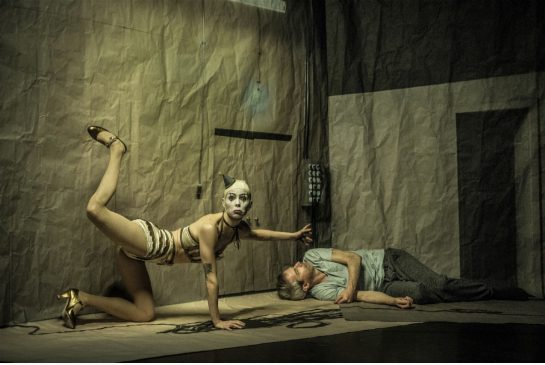Betroffenheit
By Crystal Pite and Jonathon Young
Kidd Pivott & Electric Company
Presented by Canadian Stage
Bluma Appel Theatre, Toronto
February 18 to 21, 2016
Something very menacing is certainly going on as the lights come up on Betroffenheit. In an industrial room with a pair of doors, an electric panel, and a wall-mounted telephone, there’s a tangle of dangerous-looking cables. One of the thick cables, and then another and another, comes alive and snakes across the floor and up the wall. This scene was enough to get a serpent-scared viewer into a state of high anxiety, even before the unseen figure huddled in a corner (Jonathon Young) rises to his feet in a panic. (Hence the title, a German word that means a state of shock and bewilderment in the wake of disaster.)
Betroffenheit could serve as a very good depiction of post-traumatic stress syndrome, its causes and cures. But artistically, Crystal Pite and Jonathan Young have achieved something unsurpassed with this show, developed at the Banff Centre and premiered at the Pan American games in Toronto in July.
A lot of dialogue, repeated and mouthed by Young and other performers, runs through the first part of Betroffenheit, along the lines of “system failure . . .hold on, hold on . . . stay put . . . repeat: do not move . . .collapse approaching . . .” Young appears as the chief victim, trapped in a room where doors don’t open and the phone doesn’t connect.
Simultaneously, a show is being mounted as performers carrying props and costumes parade through, exiting by another door on the bare set. The dialogue could equally apply to the process of putting on a variety show, which always involves potential disaster, perfect (or imperfect) timing and changes of approach.
It’s the profound contrast between an obvious accident and vaudevillian routines, done in jaunty style, that heightens the nervousness we experience in part one. This troupe of six performers is astonishing. The first to appear in clown face-paint is Jermaine Spivey, a Kidd Pivott member since 2008. He plays doppelganger to Young’s figure. When, in spangled turquoise three-piece suits and patent-leather shoes they perform a soft-shoe number, you don’t know whether to laugh or cry.
Interspersed with their antics, a white-faced Cindy Salgado in a sequined two-piece that might have been created by Liberace, spiders around the set like a trapeze artist who lost her way. A canvas bearing a painting of the room forms a moving, collapsing building as the dancers cross the stage under it. The many exits and entrances drive this first 45-60 minutes like so many horrible distractions. The state of confusion we feel is complete as the curtain comes down at the intermission.
A tall steel pillar in shadow dominates the bare stage in the second part of Betroffenheit. The shadowy column at first suggests a possible escape route, and then serves as a kind of memorial. Owen Belton’s soundscape of gritty, industrial, electronic emergency sounds alternates with a moving piano piece and other totally encompassing sounds as the dancers, now in drab blue and grey gym clothing, work through a series of intricately choreographed combinations that amount to a catharsis in motion.
Notable are the ways that Spivey and others make puppets of themselves, tugging at their knees to manipulate their own feet. The imagery of duality brings to mind the way a person in a disaster might be at once suffering and watching himself go through it.
The timing involved in the rapidly morphing ensemble makes Betroffenheit a wonder in performance terms alone. The group forms a tumbling, ever-changing entity, a metaphor for the feelings a participant in disaster must undergo. The last man on stage makes a quiet, slow exit to music suitable for a requiem, and brings a lump to the throat.

This sounds very cool! I look forward to seeing it…
LikeLike